 Media Blasting FAQs
Media Blasting FAQs
Media blasting, also known as sandblasting, is a process that involves using abrasive material to strip a surface of unwanted coatings, rust, or other contaminants. It is an effective and efficient method of restoring or preparing surfaces for new coatings or finishes. However, many people are not familiar with this process and may have questions about it. In this article, we will explore some frequently asked questions about media blasting.
1. What materials can be media blasted?
Media blasting can be used on a wide range of materials, including metal, wood, concrete, glass, and plastic. The abrasive material used varies depending on the type of surface being blasted. For example, sand is typically used for metal surfaces, while baking soda may be used for delicate surfaces like glass.
2. What surfaces can be media blasted?
Media blasting can be used on a variety of surfaces, both large and small. It can be used to strip away rust and old paint on metal surfaces, smooth out rough concrete surfaces, or prep wood surfaces for staining or painting. It is a versatile and effective method for surface preparation.
3. What are the benefits of media blasting?
Media blasting has several benefits, including its ability to strip surfaces clean of unwanted coatings, rust, and contaminants. It is also a cost-effective and time-efficient method of surface preparation, as it can be done quickly and with minimal downtime. Additionally, media blasting leaves a clean and smooth surface, ready for new coatings or finishes.
4. How does media blasting work?
Media blasting works by using compressed air to propel abrasive material onto a surface at high speeds. This abrasive material then strips away the unwanted coatings, rust, or contaminants. The size and shape of the abrasive material used will depend on the surface being blasted and the level of abrasiveness needed to achieve the desired result.
5. Is media blasting safe?
Media blasting is generally safe when performed by trained professionals who follow proper safety protocols. However, there are some risks associated with media blasting, including hearing damage, inhalation of dust and debris, and eye injuries. It is important to wear protective gear and make sure that the blasting area is properly ventilated.
6. What types of abrasive material can be used for media blasting?
There are several abrasive materials that can be used for media blasting, including sand, glass beads, walnut shells, baking soda, and aluminum oxide. The type of abrasive material used will depend on the surface being blasted and the level of abrasiveness needed to achieve the desired result.
7. Can media blasting be used for automotive restoration?
Yes, media blasting is a popular method for restoring automotive surfaces. It can be used to strip away old paint, rust, and other surface contaminants from metal surfaces, leaving a clean and smooth surface ready for a new coat of paint. Media blasting can also be used on plastic and glass surfaces commonly found on car exteriors.
8. Can media blasting be used for marine restoration?
Yes, media blasting is a popular method for marine restoration. It can be used to strip away rust, old paint, and other surface contaminants from metal surfaces commonly found on boats and yachts. It can also be used on fiberglass and other delicate surfaces.
9. Can media blasting be used for industrial cleaning?
Yes, media blasting is commonly used for industrial cleaning. It can be used to strip away grime, dirt, and other contaminants from industrial machinery and equipment, leaving a clean and smooth surface ready for use. Additionally, media blasting can be used to clean up industrial surfaces that have been contaminated with hazardous materials.
10. What is the difference between media blasting and sandblasting?
Media blasting and sandblasting are essentially the same process, with the difference lying in the type of abrasive material used. Sandblasting uses sand as the abrasive material, while media blasting can use a range of abrasive materials, including sand, glass beads, baking soda, and walnut shells.
Final Thoughts
Media blasting is a versatile and effective method of stripping surfaces clean of unwanted coatings, rust, and other contaminants. It can be used on a wide range of surfaces and materials, and is an excellent choice for automotive, marine, and industrial restoration projects. By understanding the benefits and risks of media blasting and working with a trained professional, you can achieve excellent results in your surface preparation projects.
